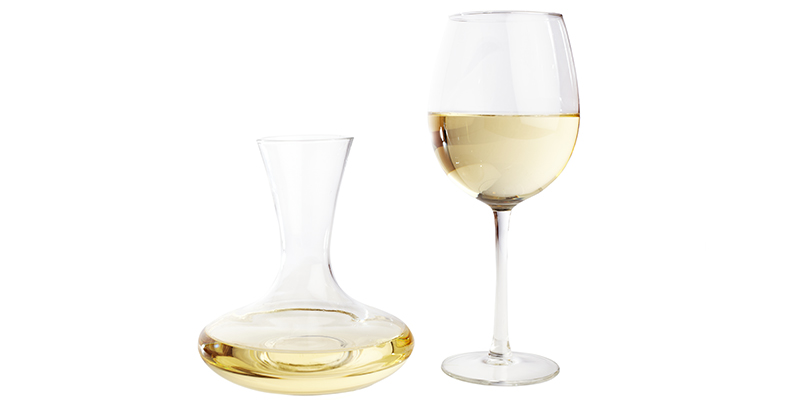More often than not, when we see a decanted wine, it’s red, not white. And for good reason. Red wines more often have sediment (which you’d want to decant out) and many, so-called “tighter” red wines can benefit hugely from “opening up,” i.e. getting some exposure to oxygen for varying amounts of time to let the aromatics have a chance to peek out. (Oxygen, however, does eventually become the enemy of wine, and aromatics can float away, so decant, and drink!)
But with all the red wines being poured into fancy crystal containers (and/or blenders) out there, we wondered whether whites could also benefit from bit of decanting. Answer: yeah, a bit. For any wine, brief exposure to oxygen can’t hurt—it’s when that exposure becomes uncontrolled and protracted that flavors get all crummy. But a brief kiss of fresh air on a wider surface area (which is what decanting vessels are designed to achieve) generally shouldn’t hurt any wine—whites included.
Not only can decanting not hurt white wines, it can actually help whites, for a few specific reasons. One: temperature. We tend to drink white wines cold, and store them in the fridge. Twenty minutes of decanting could help accelerate bringing the wine down to a slightly less frigid temp. (Fun fact, you can also decant a white wine if it’s too warm—immerse the decanter in an ice bath and that increased exposure to cold will help cool the wine faster.)
Don't Miss A Drop
Get the latest in beer, wine, and cocktail culture sent straight to your inbox.Like reds, certain whites, can also pour out a little tight—sometimes due to being too cold, sometimes depending on the grape varietal (some Chardonnays can express very differently after some decanting). In that case, a little extended exposure to oxygen might free up some much-needed aromatics, and show a little more dimensionality in a white that seems crisp and refreshing, sure, yet might have a bit more to it. And then—and here’s a newbie—there’s the presence of mercaptans, basically sulfur-derived compounds that tend to thrive in the anaerobic environment of screwtop wine bottles (the kind that plenty of “young,” and/or “ready to drink” white wines come in). Mercaptans, it turns out, tend to bring a lot of that sulfur character to the top layer of your wine’s aromatics—cabbage, rotten stuff, rubber, etc. Not all mercaptans are bad, in fact some contribute to varietal character. But most whites, certainly screwtop whites, could use even a brief, “airing out,” to let those sulfur-derived compounds go.
As for which white wines to decant, there are a couple easy differentiations: any relatively young white wines, generally meant to be consumed now, don’t really need to be decanted (but see above, especially for screwtops, or cold wines; plus, it looks cool). But the truth is, if you’ve got a decanter (or a clean jar, really anything that can increase the wine’s surface area), experiment with your favorite whites. Try it non-decanted, after 20 minutes, 40, and so on. By the end, you’ll probably think decanted wine is the greatest thing in the world—but that’s only because you’ll have had 4 glasses.
Some folks even choose to decant their Champagne (presumably not the same set that goes for rapid pseudo-bong consumption of Champagne). Debate persists over the idea, since for many drinkers, the lively pearlescence of Champagne is part of the pleasure, and would theoretically dissipate as the Champagne decants. But it seems if we’re talking age-worthy, older Champagnes, where the mousse has softened into a sort of textural background noise, decanting might not kill as many bubbles but would bring out some of the deeper complexities.

